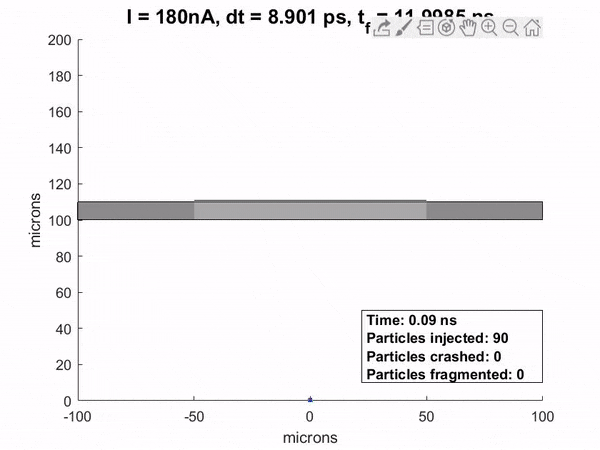
Plasma Modeling
We study the multiscale modeling of electrospray thruster plume, from binary inter-particle collisions (nm scale) to plume interactions (mm scale) in an array and multi-array effects (cm scale). We aim to patch the models at different size scales to form a comprehensive plume model that will capture all the complex underlying physics driving the plume evolution.

Molecular dynamics simulations of propellant-propellant interactions
(PhD Student: Abu Taqui Md Tahsin)
Electrospray thrusters represent an attractive technology for micropropulsion of small satellites. They produce thrust by ejecting charged molecules at high velocities using strong electric fields. However, the molecules present in the plume are susceptible to collision, chemical reaction, and fragmentation, which may introduce different new species with various mass-to-charge ratios inside the plume. Prediction of the byproducts that appear upon collisions is of prime importance to predicting the evolution of the plume and estimating the performance and the lifetime expectancy of the thruster. We use molecular dynamics simulations on the Large-scale Atomic Molecular Massively Parallel Simulator (LAMMPS) to investigate monomer-neutral collisions at different impact configurations, impact energies, and impact parameters, and obtain the mass spectra of the resulting species.

Pure Momentum Exchange

Ionic Fragmentation

Charge Exchange

Covalent Fragmentation

Recombination
Five types of monomer-neutral collisions [Tahsin et al., AIAA SciTech 2024]
Molecular dynamics simulations of propellant-surface interactions
(PhD Student: Rafid Bendimerad)
Electrospray thrusters are of particular interest for micropropulsion because of their compactness and high specific impulse. However, due to off-axis emission and narrow extractor grid apertures, a non-negligible fraction of the plume collides with the extractor grid and, therefore, reduces the efficiency and limits the lifetime of the electrospray thruster. This phenomenon is investigated using molecular dynamics (MD) simulations with the Large-scale Atomic Molecular Massively Parallel Simulator (LAMMPS) program. MD simulations allow the determination of the thermodynamic properties of the colliding molecule (EMI-BF4) and the extractor grid surface (Au), as well as the characterization of the behavior of the molecule after the collision. Three different regimes are characterized: deposition at low impact energies, reflection without fragmentation at medium impact energies and reflection with fragmentation at high impact energies.

Collision of the neutral molecule with Gold wall
[Bendimerad & Petro, IEPC 2022]
n-body Ion Beam Simulation
(PhD Students: Adler Smith, Rafid Bendimerad)
A gridless particle-particle simulation technique is used to model the acceleration region of a single emitter [Petro et al., JAP 2022]. This model includes the electrohydrodynamic emission (EHD) model [Gallud et al., JFM 2022] to inject particles into the computational domain. Charged particles are accelerated downstream due to a Laplace field between the emitter and the extractor. A leap-frog integrator is used to integrate the particle trajectories.

324 nA n-body simulation
Kinetic Ion Beam Modeling for Electrospray Thrusters
Sustainable space exploration requires longevity and flexibility in satellite platforms. For small satellites, compact electric propulsion devices such as electrospray thrusters can significantly extend lifetime and capability. As these devices operate under different principles and with more complex propellants than traditional plasma thrusters, fundamental modeling of the ion emission process and plume-spacecraft interactions are required. Towards this end, we have developed a kinetic model of the plume evolution of an electrospray ion source that tracks processes at the individual ion level. This model can be used to predict the trajectory of plume ions and neutral bi-products and their impact on performance. As a spacecraft-integrated device would have thousands of emission sites, further research will include the physics of the composite plume.

[Petro et al., IEPC 2019]
Expansion to Multi-emitter Arrays
(PhD Student: Adler Smith)
A multi-scale approach to multi-emitter electrospray ion source modeling has been developed and integrated with the Air Force Research Laboratory’s (AFRL) Thermophysics Universal Research Framework (TURF). This framework is used to extend single-emitter models of electrospray plume evolution to the array-scale using the PIC method. Source models for individual emission sites are informed by an n-body single-emitter model. Molecular effects such as ion-cluster fragmentation are included. This model is used to predict array-level properties such as plume divergence angle, and demonstrate the computational feasibility of modeling many emitters in parallel.

[Smith et al., AIAA SciTech / JPP 2023]
Designing Propulsion systems for In-Situ Resource Compatability
We have been studying the efficacy of replacing traditional noble gas propellants used in plasma propulsion devices with gaseous water. We have analyzed plasma generation efficiency which is applicable to a range of propulsion devices [1] and the efficiency of various non-contact plasma acceleration schemes [2,3]. Methods we have used include plasma-chemical analyses coupled with particle-in-cell modeling and quasi-1D plasma flow approximations. Our current research focus involves the study of dual-mode devices for flexible mission architectures using a shared propellant and efficiency improvements for water-plasma devices.
[1] Petro and Sedwick, Effects of Water Vapor Propellant on Electrodeless Thruster Performance, AIAA Journal of Propulsion and Power, 2017.
[2] Petro, Brieda, and Sedwick, PIC Simulations of Chemistry Effects in an Electrodeless Water Plasma Thruster, Proceedings of AIAA Propulsion and Energy Forum, 2019.
[3] Petro and Sedwick, Effects of Water Vapor Propellant on Helicon Thruster Performance, Proceedings of AIAA Propulsion and Energy Forum, 2016.

Electric Propulsion and Mission Design
The choice of propulsion system is deeply tied to mission objectives and spacecraft properties. Electric propulsion systems often enable missions that are otherwise infeasible with less fuel-efficient propulsion architectures. For these missions, the propulsion system, spacecraft, and trajectory are closely coupled throughout the formulation and design process. We are interested in exploring new ways that electric propulsion and other revolutionary architectures can enable new solar system science and we are working to develop tools to explore this design space more efficiently.

[1] Petro and Sedwick, Survey of Moderate-Power Electric Propulsion Systems, Journal of Spacecraft and Rockets, Vol. 54, No. 3, 2017.
[2] Sheerin, Petro, Lozano, and Lubin, Fast Solar System Transportation with Electric Propulsion Powered by Directed Energy, Acta Astronautica, vol. 179, 2021.
[3] MacKensie, et. al., THEO Concept Mission: Testing the Habitability of Enceladus’s Ocean, Advances in Space Research, Vol. 58, No. 6, 2016.

